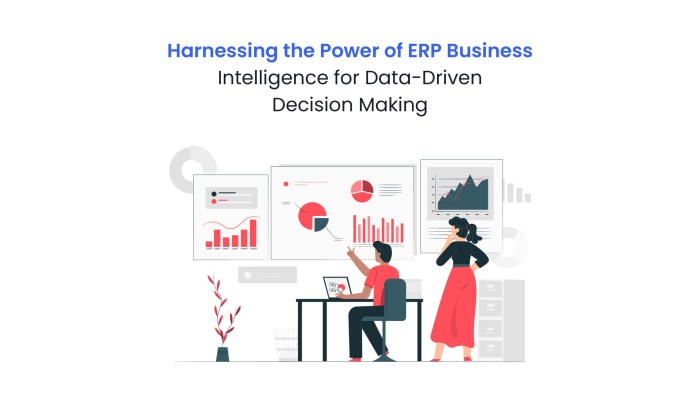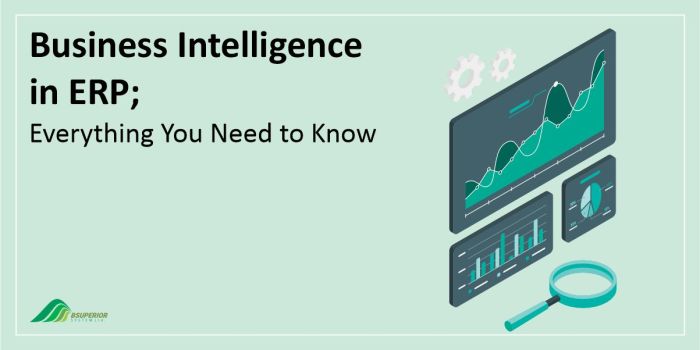Defining the Integration Landscape

Integrating business intelligence with enterprise resource planning systems – Integrating Business Intelligence (BI) with Enterprise Resource Planning (ERP) systems is a strategic move for businesses aiming to unlock deeper insights from their operational data. This integration allows for a more holistic view of the business, facilitating better decision-making and improved operational efficiency. Understanding the different types of systems and integration approaches is crucial for a successful implementation.
ERP System Types and Functionalities
Enterprise Resource Planning systems are the backbone of many organizations, managing crucial business processes across various departments. Different ERP systems cater to specific industry needs and organizational sizes. Common types include:
- Tier 1 ERP Systems: These are large-scale, complex systems designed for multinational corporations with extensive operational needs. Examples include SAP S/4HANA and Oracle Cloud ERP. They offer comprehensive functionalities across finance, supply chain, human resources, and more.
- Tier 2 ERP Systems: These systems are suitable for mid-sized businesses and offer a balance between functionality and cost. Examples include Microsoft Dynamics 365 and Infor ERP. They often provide industry-specific modules and customization options.
- Tier 3 ERP Systems: These are typically cloud-based and designed for smaller businesses with simpler operational requirements. They often focus on specific functionalities like accounting or inventory management and are known for their ease of use and affordability. Examples include Xero and QuickBooks.
Business Intelligence Tool Categories and Capabilities
Business Intelligence tools are essential for transforming raw data into actionable insights. They range from simple reporting tools to advanced analytics platforms. Key categories include:
- Reporting and Dashboards: These tools provide pre-built reports and interactive dashboards to visualize key performance indicators (KPIs) and track business performance.
- Data Warehousing and Data Lakes: These act as central repositories for storing and managing large volumes of data from various sources, including ERP systems. They are crucial for supporting advanced analytics.
- Advanced Analytics: This category includes tools for performing complex data analysis, such as predictive modeling, machine learning, and data mining, enabling businesses to forecast future trends and make data-driven decisions.
- Data Visualization Tools: These tools focus on creating visually appealing and easy-to-understand representations of data, making complex information accessible to a wider audience.
Synergies and Conflicts Between ERP and BI Systems
Integrating ERP and BI systems offers significant synergies, enabling businesses to gain a comprehensive understanding of their operations. However, potential conflicts can arise.Synergies include improved decision-making based on real-time data, streamlined reporting processes, and enhanced operational efficiency. Conflicts may involve data inconsistencies, integration complexities, and the need for significant investment in infrastructure and expertise. Careful planning and a phased approach are crucial to minimize these conflicts.
Integration Approaches
Several approaches exist for integrating ERP and BI systems, each with its own advantages and disadvantages.
| Approach | Advantages | Disadvantages | Implementation Complexity |
|---|---|---|---|
| Real-time Integration | Provides up-to-the-minute data for immediate decision-making; enhanced operational efficiency. | High implementation cost; requires robust infrastructure; potential performance issues. | High |
| Batch Integration | Simpler to implement; less demanding on infrastructure; cost-effective. | Data is not always current; may lead to delays in decision-making. | Low |
| ETL (Extract, Transform, Load) | Flexible; allows for data cleansing and transformation; suitable for large datasets. | Can be time-consuming; requires specialized skills; potential for data loss. | Medium |
| API-based Integration | Flexible and scalable; allows for real-time or batch processing; facilitates integration with other systems. | Requires technical expertise; potential for security vulnerabilities if not properly managed. | Medium to High |
Data Integration Strategies: Integrating Business Intelligence With Enterprise Resource Planning Systems
Integrating Business Intelligence (BI) with Enterprise Resource Planning (ERP) systems unlocks a treasure trove of actionable insights. But navigating the complexities of data integration requires a strategic approach. Choosing the right method and implementing a robust process is crucial for success. This section explores various data integration strategies, focusing on practical steps and potential challenges.
Different methods exist for integrating ERP and BI data, each with its own strengths and weaknesses. Understanding these nuances is vital for selecting the most effective strategy for your specific needs and infrastructure.
Data Integration Method Comparison
Several methods facilitate the flow of data between ERP and BI systems. Direct database access offers speed and efficiency for simple integrations, while APIs provide flexibility and scalability for more complex scenarios. Data warehousing provides a centralized, structured repository for comprehensive analysis.
| Method | Description | Advantages | Disadvantages |
|---|---|---|---|
| Direct Database Access | Directly querying the ERP database using BI tools. | Fast, efficient for simple integrations. | Can impact ERP performance, security risks, lacks flexibility. |
| APIs | Using application programming interfaces to exchange data. | Flexible, scalable, secure, allows for real-time data integration. | Requires technical expertise, potential for integration complexity. |
| Data Warehousing | Creating a separate data warehouse to store and process data from ERP and other sources. | Improved data quality, performance optimization for BI, centralized data management. | Increased infrastructure costs, complexity in data modeling and ETL processes. |
Implementing an ETL Process
Extract, Transform, Load (ETL) is a cornerstone of successful ERP-BI integration. A well-defined ETL process ensures data accuracy, consistency, and timely availability for BI analysis. The following steps Artikel a typical ETL implementation.
- Data Extraction: Identify the relevant data sources within the ERP system (e.g., sales orders, inventory levels, financial transactions). Use appropriate methods (database queries, APIs) to extract the data.
- Data Transformation: Cleanse, standardize, and transform the extracted data to match the requirements of the BI system. This may involve data type conversions, handling missing values, and data deduplication.
- Data Loading: Load the transformed data into the target BI system (data warehouse, data mart, or directly into the BI tool). Ensure data integrity and efficient loading mechanisms.
- Data Validation: Verify the accuracy and completeness of the loaded data through data quality checks and comparisons with source data.
- Monitoring and Maintenance: Regularly monitor the ETL process for performance and data quality issues. Implement mechanisms for error handling and process recovery.
Data Quality and Governance Challenges
Maintaining high data quality and implementing robust data governance are crucial for reliable BI insights. Inconsistent data formats, missing values, and data errors can significantly impact the accuracy and reliability of analyses.
Implementing data quality rules, establishing data ownership, and enforcing data standards are essential aspects of data governance. Regular data audits and reconciliation processes help identify and address data quality issues proactively. For example, discrepancies in sales figures between the ERP system and the BI dashboard might indicate a data integration problem requiring immediate attention.
Designing an Integrated Data Model
A well-designed data model is crucial for effective integration. It needs to capture key ERP data points and align with BI visualization requirements. The model should support efficient querying and analysis, ensuring data consistency and minimizing redundancy.
A star schema, for instance, is a common approach. A central fact table contains key business metrics (e.g., sales amount, quantity sold), linked to dimension tables representing contextual information (e.g., customer, product, time, location). This structure facilitates efficient querying and reporting for BI dashboards. For example, a fact table might contain sales transactions, linked to dimensions for customers, products, and time periods, allowing for flexible analysis of sales performance across different dimensions.
Building BI Dashboards and Reports

Integrating ERP and BI systems unlocks a treasure trove of data, but its true value lies in transforming this raw information into actionable insights. Effectively designed dashboards and reports are the key to unlocking this potential, providing a clear and concise view of critical business performance indicators. This section explores the creation of insightful dashboards and reports leveraging the power of integrated ERP and BI data.
Example Dashboards Showcasing Key Performance Indicators (KPIs)
A well-designed dashboard provides a high-level overview of key business metrics. Consider a dashboard for a retail company integrating its ERP and BI systems. One section could display a geographical heatmap showing sales performance across different regions, with darker colors indicating higher sales volumes. Adjacent to this, a bar chart could compare year-over-year sales growth for each region. A third element could be a real-time display of current inventory levels for top-selling products, updating dynamically as sales transactions are processed through the ERP system.
Finally, a key performance indicator (KPI) card could show the overall customer satisfaction score, derived from data integrated from the ERP system and customer relationship management (CRM) system. Each visual element provides a distinct perspective on the business’s performance, enabling quick identification of trends and areas requiring attention.
Best Practices for Designing Interactive Dashboards that Support Decision-Making, Integrating business intelligence with enterprise resource planning systems
Interactive dashboards empower users to drill down into data, exploring underlying details and uncovering hidden patterns. Effective interactive dashboards should allow users to filter data by various parameters (e.g., time period, product category, sales region), customize the displayed KPIs, and easily export data for further analysis. The use of clear and concise labels, intuitive navigation, and consistent color schemes is paramount.
Notice best practices for data visualization in business intelligence for recommendations and other broad suggestions.
Dashboards should also be responsive, adapting seamlessly to different screen sizes (desktops, tablets, and smartphones). For example, a retail manager could use an interactive dashboard to filter sales data by specific product lines and analyze sales trends across different regions, identifying potential areas for promotional campaigns or inventory adjustments.
Benefits of Using Different Visualization Techniques for Presenting ERP-Derived BI Insights
Different visualization techniques cater to different data types and analytical needs. For instance, line charts are ideal for visualizing trends over time, such as sales revenue or customer acquisition costs. Bar charts effectively compare different categories, such as sales performance across various product lines. Pie charts illustrate proportions, such as the market share of different products. Geographical maps effectively display spatial data, such as sales performance across different regions.
Scatter plots can reveal correlations between variables, for example, the relationship between marketing spend and sales revenue. The judicious selection of visualization techniques is crucial for effective communication of insights. For example, visualizing sales data by region on a map allows for quick identification of high-performing and underperforming areas, whereas a line chart might show overall sales trends over time.
Creating a Report Detailing Sales Trends Analyzed Using Integrated Data
A sales trend report might include the following data fields: Date, Product ID, Product Name, Quantity Sold, Unit Price, Total Revenue, Sales Region, and Sales Representative. Calculations could include total revenue per product, total revenue per region, average unit price, and year-over-year sales growth. The report could be generated automatically at specified intervals, or on demand, pulling data directly from the integrated ERP and BI systems.
For example, a calculation of year-over-year sales growth could be performed using the following formula:
(Current Year Revenue – Previous Year Revenue) / Previous Year Revenue100%
. This report provides a detailed analysis of sales performance, enabling identification of top-selling products, high-performing sales regions, and areas requiring improvement.
Security and Governance Considerations

Integrating business intelligence (BI) with enterprise resource planning (ERP) systems unlocks significant business value, but it also expands the attack surface and necessitates robust security measures. A well-defined security and governance framework is crucial to protect sensitive data, ensure compliance, and maintain the integrity of the integrated system. Ignoring these aspects can lead to data breaches, regulatory penalties, and significant financial losses.Data security and governance are paramount in any BI-ERP integration project.
This involves implementing a comprehensive strategy that addresses data access, encryption, audit trails, and compliance with relevant regulations like GDPR, CCPA, and HIPAA. A proactive approach to security minimizes risks and builds trust in the system’s reliability and the integrity of the data it processes.
Data Security Risks in BI-ERP Integration
Integrating ERP and BI systems introduces new vulnerabilities. Unauthorized access to sensitive financial, operational, or customer data is a major concern. Data breaches can result from weak passwords, insufficient access controls, or vulnerabilities in the integrated systems themselves. Moreover, the increased volume and complexity of data flowing between systems can make it harder to detect and respond to security incidents.
Poorly configured data pipelines can also create opportunities for data exfiltration.
Best Practices for Data Security and Compliance
Implementing robust access controls is fundamental. This involves employing role-based access control (RBAC) to restrict access to data based on user roles and responsibilities. Data encryption, both in transit and at rest, is crucial to protect sensitive information from unauthorized access. Regular security audits and penetration testing help identify and address vulnerabilities before they can be exploited.
Maintaining comprehensive audit trails allows for tracking data access and modifications, aiding in incident response and compliance audits. Finally, adherence to relevant data privacy regulations is non-negotiable.
Establishing Data Governance Policies and Procedures
Effective data governance requires clearly defined policies and procedures for data access, usage, and security. This includes establishing data ownership, defining data quality standards, and implementing processes for data lifecycle management. A data governance framework should specify roles and responsibilities for data management, ensuring accountability and consistency. Regular data quality checks and remediation processes are vital to maintain the accuracy and reliability of the integrated data.
The policies should also address data retention and disposal procedures, complying with legal and regulatory requirements.
Mitigating Security Risks
A multi-layered security approach is essential.
- Implement strong authentication mechanisms, including multi-factor authentication (MFA), to prevent unauthorized access.
- Encrypt sensitive data both in transit (using HTTPS) and at rest (using encryption at the database level).
- Regularly update and patch ERP and BI systems to address known vulnerabilities.
- Conduct regular security audits and penetration testing to identify and remediate weaknesses.
- Implement robust access controls using role-based access control (RBAC) to limit access to sensitive data based on user roles.
- Establish a comprehensive data loss prevention (DLP) strategy to prevent sensitive data from leaving the organization’s control.
- Implement data masking and anonymization techniques to protect sensitive data during development and testing.
- Monitor system activity for suspicious behavior and promptly investigate any security incidents.
Return on Investment (ROI) and Value Realization
Integrating Business Intelligence (BI) with Enterprise Resource Planning (ERP) systems isn’t just a technological upgrade; it’s a strategic investment aimed at boosting efficiency and profitability. This integration unlocks a wealth of data-driven insights, transforming how businesses operate and make decisions. The key to realizing the full potential lies in understanding and measuring the return on this investment.
Improved operational efficiency and enhanced decision-making are the cornerstones of a successful ERP-BI integration. By connecting disparate data sources, businesses gain a unified view of their operations, leading to streamlined processes and reduced waste. This allows for proactive identification of bottlenecks, optimized resource allocation, and improved forecasting accuracy, all contributing to a significant increase in overall profitability.
Methods for Measuring ROI
Measuring the ROI of an ERP-BI integration requires a multifaceted approach. It’s not simply about calculating the initial investment against immediate cost savings. Instead, a comprehensive evaluation should encompass both tangible and intangible benefits. Tangible benefits are easily quantifiable, such as reduced labor costs, decreased inventory holding costs, and improved sales conversion rates. Intangible benefits, such as improved customer satisfaction and enhanced employee morale, are harder to quantify but equally important to consider.
A robust ROI calculation should incorporate both, using a combination of quantitative and qualitative data. Key performance indicators (KPIs) should be defined upfront to track progress and measure success against pre-defined targets. For instance, tracking order fulfillment time, inventory turnover rate, and customer satisfaction scores can provide valuable insights into the integration’s effectiveness. Regular reporting and analysis of these KPIs are crucial for monitoring the ongoing value delivered by the integrated system.
Hypothetical Case Study: Supply Chain Optimization
Let’s imagine a mid-sized manufacturing company, “Acme Widgets,” struggling with inefficient supply chain management. Their disparate systems resulted in inaccurate inventory levels, leading to stockouts and excess inventory. Order fulfillment was slow, and customer satisfaction suffered. After integrating their ERP and BI systems, Acme Widgets implemented a real-time inventory tracking system. This provided accurate visibility into stock levels across the entire supply chain.
The BI dashboard highlighted potential stockouts and enabled proactive reordering, reducing stockouts by 40% within six months. Simultaneously, improved demand forecasting, driven by BI analytics, reduced excess inventory by 25%, resulting in a 15% reduction in warehousing costs. The improved efficiency in order fulfillment reduced lead times by 20%, leading to a 10% increase in customer satisfaction scores.
The combined impact of these improvements resulted in a 12% increase in profitability within the first year. This demonstrates how the integration not only improved operational efficiency but also directly translated into significant financial gains. The initial investment in the integration was quickly recouped through these efficiency gains and increased profitability.